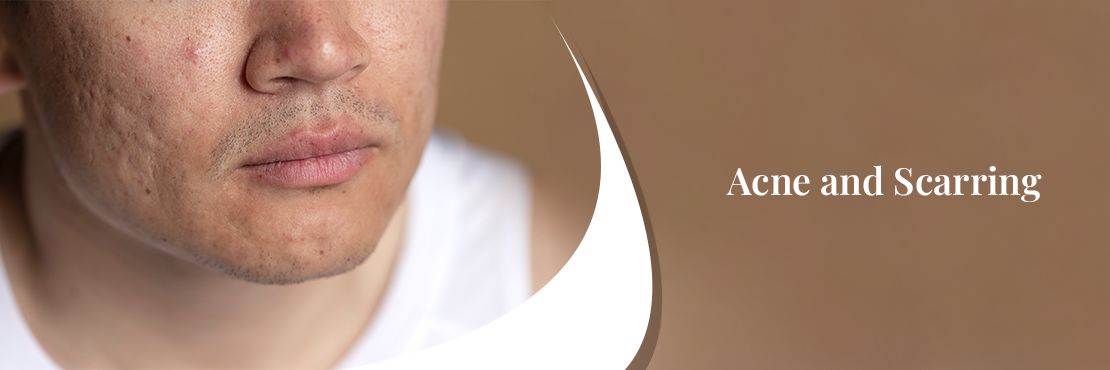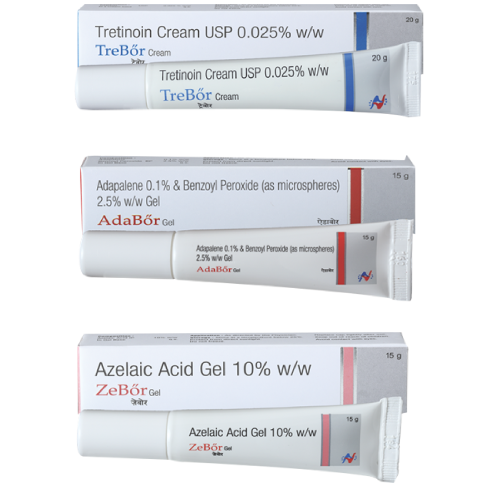Acne & Scarring

Do you know what acne and scarring are?
Acne scars are caused by inflammation of acne blemishes. They commonly occur on the face, chest, and back. 80% of people between ages 11 and 30 will get acne, and one out of five will develop scars.
It has become a reason for botheration and embarrassment, especially for youth now!
What causes acne?
An acne lesion or pimple occurs when bacteria, oils, and dead skin build-up and inflame pores, the tiny openings through which oil and sweat escape your skin. About 40,000 dead cells fall off your skin every hour, clogging up your pores. Some clogged pores are tiny and cause whiteheads and blackheads, while others become inflamed and cause other types of acne.
It is the most common skin condition worldwide. Teenagers get acne due to hormonal changes. Adults get acne due to stress, the environment, menstrual cycles, oil-based products, and birth control pills, although hormones play a role too.
What are the types of acne, and what do they look like?
Acne occurs in many different forms. Whiteheads and blackheads are typical and tend to heal smoothly more often than not. Then there are the types that can lead to scarring:
- Papules: Pink to red bumps that hurt when you touch them.
- Pustules: Pus-filled lesions. They're red at the base and white or yellow at the top.
- Nodules: Solid lesions. They're larger than papules and pustules and can hurt more because they extend deeper into the skin.
- Cysts: Cysts lie deep within the skin. They're painful, full of pus, and are most likely to scar.
How does acne cause scars?
The skin is the largest organ in your body. It has three main layers. The outermost layer is the epidermis, the dermis, and the hypodermis. These layers protect your body's fragile insides from UV rays and bacteria.
They also help produce vitamin D, thanks to sunlight. Any area with sebaceous glands is prone to acne — especially the face, back, and chest.
There are several causes of acne scarring, including inflammation of acne blemishes, swollen pores, and a breakdown of the pore wall. Acne blemishes are minor, leaving shallow scars that heal quickly. However, sometimes blemishes spill into the surrounding tissues and cause deeper scarring. By forming thick collagen fibers, the skin resurfaces and repairs the scar.
Acne scars take on two primary forms: either a scar develops when there is a loss of tissue, resulting in an indentation in the surface of the skin, or a scar develops that is raised on the surface of the skin. This type of acne scar is a sign that your skin is doing its job — but perhaps, too well. Your skin creates collagen ("repair tissue") to help heal the acne wound, but if it makes too much collagen, raised scars form.
What are the types of acne scars, and what do they look like?
Atrophic or Depressed Scarring:
- Ice pick: n ice pick tool has a wide shaft that narrows to the tip. This type of acne scar resembles the device because it's a hole wide at the top and narrows to a point as it goes deeper into the skin. Such an indentation is standard and one of the most challenging scars to heal. You'll find them on your forehead and upper cheeks, where your skin is thinner.
- Rolling: These scars are typically found on the lower cheeks and jaw, where your skin is thicker. The indents have sloping edges that make the skin look uneven and wavy.
- Boxcar: Boxcar scars are indents that have sharper edges. Those edges go down deep into the skin. These scars are standard on the lower checks and jaw.
Hypertrophic or keloid scars: These scar tissue lesions rise off the skin. They're caused when fibrous tissues, collagen, in the region of the skin overgrow. These scars are usually found on the chest, back, shoulders, and jawline and can be itchy, tender, or painful.
How common is acne scarring?
Very common. About 80% of people between the ages of 11 and 30 will have acne, and one out of five of that population will have scarring. Teenagers are the hardest hit. Nearly 90% of them will get acne and the major reason for their embarrassment.
Here are a few symptoms and causes of acne:
What causes acne? Clogged pores. Dead skin, oils, and bacteria build up and inflame your pores. You might also have a genetic predisposition to acne.
What causes acne scars?
Scars happen because your body is trying to repair the acne. How your unique body responds to a wound determines if and how much scarring you'll have. The process of repair includes the creation of collagen. If there's too much collagen, then the raised scars appear. Other scars are caused by tissue loss, which creates pits or indentations in the skin.
Diagnosis and tests
How is acne diagnosed?
A dermatologist will examine your skin and determine if the lesions are consistent with acne or another dermatologic process.
How are acne scars diagnosed?
Your dermatologist will examine your skin to determine whether you have acne scarring and what type it is.
Treatment: We know that acne is not physically debilitating but more emotionally debilitating. However, believe it or not! You can now control or manage acne by yourself!
Don't believe us?
Explore these products: Trebor, Adabor, Zebo
Trebor:
Trebor containing Tretinoin comes in two strengths, 0.05%. In addition, it comes with the added advantage of Aloe Vera, which acts as a moisturizer. It is used to treat mild to moderate acne.
Adabor:
Adabor is the combination of Adapalene 0.1% and Benzoyl peroxide 2.5%. Benzoyl peroxide added in microspheres improves tolerability and better efficacy.
This synergistic combination is used in papulopustular acne.
Dermatologists prescribe the above medicines to deal with acne and scarring.
Zebor:
Zebor, composed of Azelaic Acid Gel 10%, treats acne by killing acne-causing bacteria and prevents the formation of spots or pimples.
It works as an anti-acne, anti-inflammatory, anti-aging, and skin-whitening agent.

